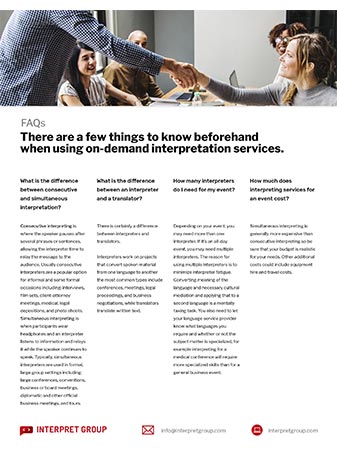Most people use the terms translator and interpreter interchangeably, but the two have very different meanings. It is especially important to understand the difference when you are looking to book language services for your project.
Translator
If you’re working with written documents – a user manual for your Swedish customers, billboards for a sales campaign in Thailand, reports filed in Mandarin by your new subsidiary in Shanghai – you need a translator.
To translate is to take text from a source language and turn it into another language while preserving its meaning.
A good translator must have the ability to write well and understand the culture of the target language. They often use a large library of dictionaries and reference materials, to ensure that they deliver a clear and accurate translation of the material.
Top 10 Requested Languages for Translation
- Arabic
- Chinese – Mandarin
- French
- German
- Italian
- Japanese
- Korean
- Portuguese
- Russian
- Spanish
Interpreter
If you want to interact with people in a foreign language on the spot – a factory tour with Mexican visitors, a board meeting in Japan, an international deposition with a German witness – you need an interpreter.
The process of interpreting consists of the interpreter listening to a speaker in one language, quickly understanding what is being said, and then conveying that meaning into the target language. Interpreters work on projects involving live translation including: conferences and meetings, clinical trials and medical events, depositions and arbitrations, factory tours and audits, workshops and trainings, press conferences, and trade missions and study tours.
Two main types of interpreting, consecutive and simultaneous
Consecutive interpreting requires the speaker to pauses every few phrases or sentences, allowing the interpreter time to verbally relay the message to the audience. Consecutive interpreters are usually the best option for informal and some formal occasions including: interviews, film sets, client-attorney meetings, medical, legal depositions, photo shoots, etcetera.
Simultaneous interpreting requires participants to wear headphones, while the interpreters listen to a speech or presentation and verbally relays it in real time, while the speaker continues to speak. Simultaneous interpreters are usually employed in formal, large group settings including: large conferences, conventions, business or board meetings, tours, etcetera.
About Interpret Group
Interpret Group delivers local interpreting and translation solutions around the world, ensuring effective communication, limiting our clients’ carbon footprint and minimizing costs. Our solutions help build communication bridges by assigning top-notch interpreting talent to your project challenges.








